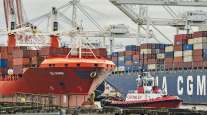CEO, PECO Pallet
Perspective: Flexibility Helps With Supply Chain Delays
[Stay on top of transportation news: Get TTNews in your inbox.]
For years, just-in-time supply chain practices were the name of the game for many companies. But in the aftermath of the pandemic and subsequent supply chain tangles, building up and keeping heavier inventories has come to the forefront as a core strategy. While there’s merit to both approaches, companies need to be prepared and take some action on unintended consequences of the new sea change.
The shift is easy to understand. For retailers, they avoid lost sales due to delayed or late arriving inventory; manufacturers can ensure there is sufficient safety stock to protect production lines from costly shutdowns due to lack of critical manufacturing ingredients and raw materials — some still sitting at ports and on containerships.
But this shift in strategy is creating consequences across supply chains. High demand for warehouse space drove logistics real estate vacancies down to 3.4% in the first quarter of 2022, while rents rose 7%, the highest increase in 20 years, according to JLL, one of the nation’s largest commercial property managers. Steel-dependent racking systems for warehouses, once delivered within months, now are taking up to a year. Deliveries of forklifts and other freight handling equipment are delayed similarly by supply chain disruptions, as are new units from truck and trailer manufacturers. And just about everything costs more.

Dagnese
One salient example of an unintended consequence is the availability of freight pallets, the wooden platform on which shipments in trucks ride. Those expanded inventories that have consumed virtually every square foot of warehouse space — they’re also consuming millions of pallets, keeping them out of circulation and unavailable for the next product to ship.
Pallets are not “one and done.” Particularly in the rental pallet market, they are recycled, repaired and reissued multiple times. Without pallets, supply chain velocity can come to a halt. More products stuck in warehouses has an unintended consequence: increased pallet “dwell,” which is the amount of time a retailer or distributor has a pallet in their possession.
Pallets are a renewable asset. As pallets are held out of circulation longer, these assets get fewer “turns” or reissues per year. Consequently, the available pool of pallets shrinks, impacting how much pallet inventory is in the network for all users — and the ability of shippers to move goods on a timely basis to meet demand.
Delay also piles up when pallets are “down-streamed.” This happens when a pallet is sent to a secondary location, such as a local store, where it may sit for several days or weeks. Since it’s no longer at the original destination warehouse, the pallet cannot be recovered at its scheduled time. It’s an unplanned trip, and a delay that keeps the pallet from being reissued to the next user, further limiting inventory.
What’s the solution? There is no silver bullet. Pallet manufacturers can build more pallets, but with lumber volatility driving elevated prices, shippers balk at the price. The simplest solution: treat pallets not as a throwaway commodity but as the critical supply chain asset they are. The quickest way to improve pallet supply is to accelerate their return into the network. Faster return doesn’t cost the shipper or 3PL a dime, and it actually helps reduce future costs by making that pallet pool more fluid.
That kind of shift in thinking, across more than just pallets, will be paramount in responding to these shifts in the supply chain. Granted, in the current environment businesses are leaning toward larger safety stocks to protect against delays from congestion and other capacity issues. Yet supply chains remain fluid, capacity is cyclical, demand ebbs and flows for everything from trucking and rail resources to warehouse space to pallet supply.
For shippers, that places a premium on “strategic flexibility” — in how you project and forecast needs, recognize trends, plan for cycles and respond. In today’s market, agility is everything. Solutions should leverage a mix of insourced and outsourced resources to deliver on logistics objectives and ensure reliability. A hybrid approach that balances just-in-time practices with just-in-case approaches to immediate inventory and safety stock should put shippers in the best position to maximize agility and still meet customer needs.
Joe Dagnese is chief executive of PECO Pallet, the second largest pallet rental pool operator in North America.
Want more news? Listen to today's daily briefing below or go here for more info:




